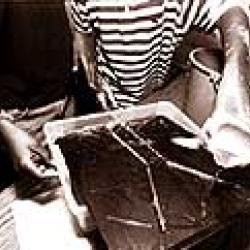Source Institutions
Source Institutions
Add to list Go to activity
Activity link broken? See if it's at the internet archive

In this activity related to flight, learners build a tiny stream channel to investigate how fluids (air and water) change speed as they flow between and around objects. It includes an explanation "What's Going on? The Simple Explanation..." for an introductory explanation. See related resource "What's Going on? The Advanced Explanation..." for an explanation of what is happening to the water and pressure during this experiment as well as how it relates to airplanes and flight. This resource is related to other resources in the SMILE Pathway: Look Mom, No Wings! and Bernoulli Brain Teasers.
- Under 5 minutes
- 10 to 30 minutes
- 1 cent - $1 per group of students
- Ages 8 - 14
- Activity, Demonstration, Experiment/Lab Activity, Lesson/Lesson Plan
- English
Quick Guide
Materials List (per group of students)
- cookie sheet
- pencils
- tape
- plastic wrap
- sink or tub
- water
- small scraps of paper or styrofoam (optional)
Subjects
-
Engineering and Technology
-
Engineering
- Aerospace Engineering
- Transportation Engineering
-
Engineering
-
Physical Sciences
-
Energy
- Potential and Kinetic Energy
-
Motion and Forces
- Gravity
- Momentum and Velocity
- Acceleration
-
States of Matter
- Liquids
-
Energy
-
The Nature of Science
-
The Scientific Process
- Conducting Investigations
-
The Scientific Process
Informal Categories
- Transportation
Audience
To use this activity, learners need to:
- see
- touch
Learning styles supported:
- Involves teamwork and communication skills
- Involves hands-on or lab activities
Other
Components that are part of this resource:
This resource is part of:
- Smithsonian Education: Lesson Plans (Science & Technology)
- How Things Fly: Activities for Teaching Flight
- How Things Fly: Lesson Plan 2
Access Rights:
- Free access
By:
- Office of Education, National Museum of Natural History; Education Department, Smithsonian Institution's National Air and Space Museum
Rights:
- All rights reserved, Smithsonian Institution, 2010
